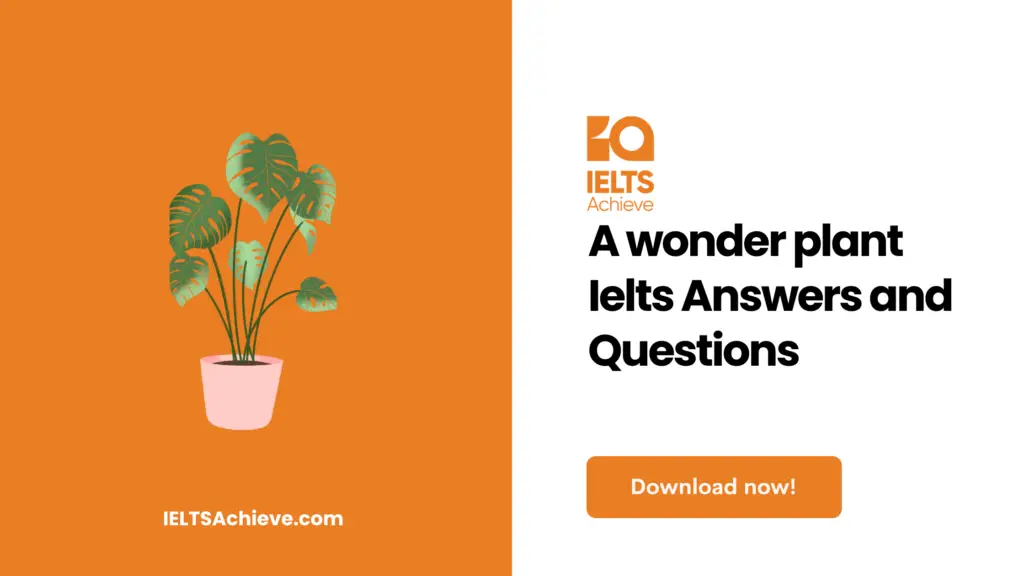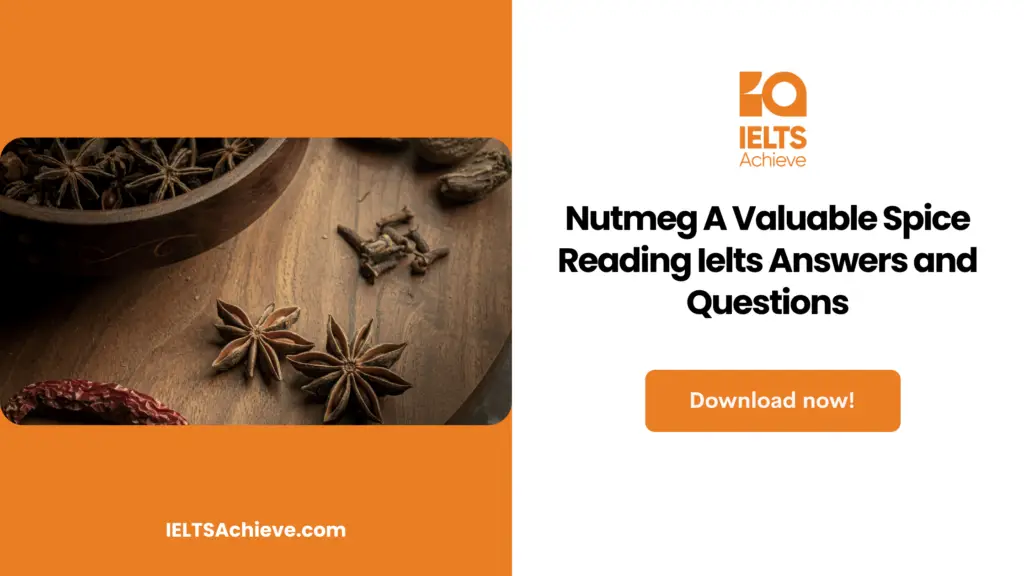The Blog post contains the following IELTS Reading Questions:
- IELTS Reading Locating Information Questions
- IELTS Reading Matching Features Questions
- IELTS Reading Short Answer Questions

IELTS Reading Passage – A Wonder Plant Reading Answers
This ‘A wonder plant reading passage’ is one of the easiest passage to read and to locate the answers for the questions. Don’t miss to check the ‘A wonder plant reading answers with location’ below.
A Wonder Plant
More than a billion people rely on bamboo for shelter or income, and many endangered species rely on bamboo for life, but the future of this miraculous plant is questionable. A recent analysis suggests that several types of bamboo are in danger, despite the plant’s widespread appearance.
A. During the rainy season, mountain gorillas in Central Africa travel to the foothills and lower slopes of the Virunga Mountains to eat bamboo. It’s a vital food source for the roughly 650 that still live in the wild. Even though they eat up to 90 percent bamboo at this time of year, they eat about 150 different kinds of plants and a variety of insects and other invertebrates. Ian Redmond, chairman of the Ape Alliance, says that without it, their chances of surviving would be much lower. Bamboo is popular with more than just gorillas. People who live near the Virungas use it as a valuable and versatile raw material for building houses and making things like mats and baskets. But in the last 100 years or so, as populations have grown and large areas of bamboo forests have been cut down to make way for farms and commercial plantations, there has been more pressure on resources.
B. Unfortunately, this is not an isolated instance. The ranges of numerous bamboo species appear to be contracting globally, affecting the humans and animals who rely on them. Despite bamboo’s significance, surprisingly little is known about it. The recent publication of a report by the UN Environment Programme (UNEP) and the International Network for Bamboo and Rattan (INBAR) has highlighted the extent of our misunderstanding about world bamboo resources, particularly in terms of conservation. There are about 1,600 species of bamboo, but the focus of this paper was on the roughly 1,200 woody kinds defined by the sturdy stems, or culms, that most people identify with this multipurpose plant. Only 38 ‘priority species’ chosen for their commercial potential have been the subject of genuine scientific inquiry, with the majority of this research focusing on their commercial viability. This issue is not exclusive to bamboo. The science of measuring the conservation status of plants is in its infancy when compared to the work conducted on animals. Dr. Valerie Kapos, one of the report’s authors and a senior advisor in forest ecology and conservation to the UNEP, states, “It’s only been in the last 10 to 15 years that people have begun to take this issue seriously, and it’s only now that we have a grasp on how to approach it methodically.”
C. A grass, like bamboo. It can be found in a wide range of sizes, from under a meter to over 40 meters in height. And some species can grow more than a meter in a single day, making them the fastest-growing woody plant on Earth. The ecological value of bamboo goes beyond its role as an animal food source and habitat. Stands of bamboo are made up of many individual plants, and all of them grow from a single rhizome. Its vast rhizome systems are vital in halting soil erosion because they anchor the earth’s upper layers. Additionally, there is mounting proof that bamboo is a critical factor in how forests are organized and how they change over time. “Bamboo’s mass flowering and dying pattern leave behind enormous regions of dry biomass that attract wildfire,” explains Kapos. When this collapse, they clear off much larger areas of the forest than a single tree would. Some plant species thrive in the early stages of regeneration when the canopy is broken up, hence this type of patchiness aids in the maintenance of biodiversity.
D. The most obvious significance of bamboo, though, is its economic value. New methods of processing have expanded their potential applications beyond traditional ones like flooring and laminates. One of the most rapidly expanding bamboo products is paper; in India, 25 percent of paper is generated from bamboo fibre, while in Brazil, 100,000 hectares of bamboo are planted specifically for paper manufacturing. Of course, the primary use of bamboo has always been in the home, and the yearly value of domestically traded bamboo is approximately $4.5 billion. Since ancient times, it has been widely employed in building due to its adaptability, suppleness, and strength (its tensile strength is comparable to that of certain steel). More than a billion people now call homes made of bamboo. An associate researcher at the Royal Botanic Gardens, Chris Stapleton, has observed that in many third-world nations, bamboo is the only readily available raw material. He argues that bamboo can be easily transformed without the need for complex technology or elaborate facilities because it can be gathered from forests or grown rapidly in other locations. “In this sense, it makes a significant contribution to both reducing poverty and increasing wealth.”
E. It is especially concerning that the UNEP report paints such a bleak image, considering the economic and ecological importance of bamboo. However, astute gardeners will recognize a seeming inconsistency. Anyone who has noticed the recent trend of growing exotic species in gardens can tell you that bamboo if allowed to grow unchecked, can pose serious issues. Kapos claims that in many regions, “those who live with bamboo don’t regard it as being endangered in any manner.” “In reality, many introduced bamboo species can become extremely invasive.” In that case, why do so many species face extinction? Ray Townsend, vice president of the British Bamboo Society and arboretum manager at the Royal Botanic Gardens, believes there are two distinct problems at play here. Several plant species face extinction because they just aren’t adapted to their natural environment. However, bamboo is capable of caring for itself and will thrive even if abandoned. The habitat in which it lives is in danger. Kapos claims that the danger to bamboo comes from physical disruption. Forests are lost when they are transformed into cattle pastures, for example, which means that forest plants like bamboo will have nowhere to thrive in the future.
F. While national parks and reserves around the world frequently include forests, there is very little that specifically protects bamboo in the wild. Some measures are being taken, if tentatively, to improve the situation. Researchers at UNEP-INBAR have produced a report that will aid in the development of effective conservation strategies to preserve imperilled wild bamboo species. Towns end agrees that the UNEP study is a major win for bamboo conservation efforts. The status of bamboo as a plant has always been low. The Amazon region’s hardwoods are the first thing that comes to mind whenever the region is mentioned. Even while these are important, the bamboo species that are frequently found near them are generally disregarded. For a variety of reasons, it’s the single most significant plant in human history. I can’t think of any plant that has such a wide range of applications and is so economically significant in so many different nations. According to him, sending scientists out into the field is the most crucial initial step. We need to study these plants in the wild to learn how they stay alive and apply that knowledge to protect them in the future.
A Wonder Plant Reading Questions
Questions 1-7
Reading passage has six sections A-FWhich section contains the following information?
Write the correct letter A-F in boxes 1-7 on your answer sheet.
(NB You may use any letter more than once.)
1. Commercial products of bamboo.
2. Limited extent of existing research.
3. A human development that destroyed large areas of bamboo.
4. How bamboos are put to a variety of uses.5. An explanation of how bamboo can help the survival of a range of plants.
6. The methods used to study bamboo.
7. Comparison of bamboo with other plant species.
Questions 8-11
Use the information in the passage to match the people (listed A-D) with opinions or deeds below.
Write the appropriate letters A-D in boxes 8-11 on your answer sheet.
(NB You may use any letter more than once)
| A | Valerie Kapos |
| B | Ian Redmond |
| C | Chris Stapleton |
| D | Ray Townsend |
8. Destroying bamboo jeopardizes to wildlife.
9. People have very confined knowledge of bamboo.
10. Some people do not think that bamboo is endangered.
11. Bamboo has loads of commercial potentials.
Questions 12-13
Answer the questions below using NO MORE THAN TWO WORDS from the passage for each answer.Write your answers in boxes 12-13 on your answer sheet.
12. Which bamboo product is getting more and more popular?13. Exactly what kind of environmental threat does bamboo’s unusual root system neutralize?
Also read: IELTS reading short answers questions.
A Wonder Plant Answers
1. D
2. B
3. A
4. D
5. C
6. B
7. E
8. B
9. A
10. D
11. B
12. Paper
13. Soil Erosion

